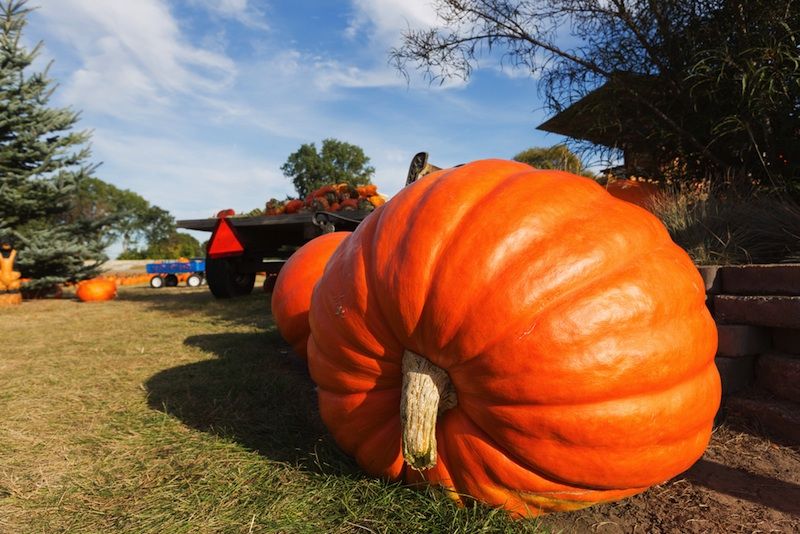
Autumn is a time for leaf peeping, jack-o'-lanterns and pumpkin pie. The bright orange globes are the quintessential symbols of the season, and spooky jack-o'-lanterns have become a staple of Halloween celebrations everywhere. But long before pumpkin spice lattes became the fall favorite at coffee shops, the fleshy gourd was a symbol of American family farms and a bountiful harvest. From their ancient roots to the biggest pumpkin ever grown, here are nine crazy facts about pumpkins.
1. Ancient plant
Pumpkins are perhaps the oldest domesticated plants on Earth, with archaeological and botanical evidence suggesting that people cultivated pumpkins as far back as 10,000 B.C., said Cindy Ott, an American studies professor at Saint Louis University in Missouri, and the author of "Pumpkin: The Curious History of an American Icon," (University of Washington Press, 2012). The first cultivated pumpkins, which were small, hard gourds that bear little resemblance to the fleshy orange giants of today, likely originated in the highlands of Oaxaca in Mexico, Ott said. [In Images: Peculiar Halloween Pumpkins]
2. Same plant, different name
The scientific name for pumpkins is Cucurbita pepo, with "pepo" meaning "to ripen in the sun." Though Americans consider pumpkins, squash and zucchini to be different foods, they are in fact all the same genus and species, and can be bred with one another. The Europeans who first saw the strange fruits thought they looked a lot like melons, so they called them "pompions," which is French for melon, Ott said.
3. Survival fruit
When the British colonists arrived in North America, they quickly learned to rely on the pumpkin as a survival food because European staples weren't readily available. Pumpkin could be substituted for wheat and barley in beer and was a fast-growing and hardy crop, Ott said.
Sign up for the Live Science daily newsletter now
Get the world’s most fascinating discoveries delivered straight to your inbox.
4. First recipe
Though Thanksgiving is now synonymous with pumpkin pie, the original colonists considered pumpkin more of a savory ingredient, and it's not clear they even ate it on Thanksgiving Day. Most preparations used pumpkin, in addition to corn, in meat stews, Ott said. The first mention of pumpkin pie seems to have been a recipe for "pumpkin pudding baked in a crust," which appeared in the first American cookbook, "American Cookery," published by Amelia Simmons in 1796, Ott said.
5. Farm feed
The pumpkin was never considered a particularly luxurious food, and by the 19th century, when European foods became more readily available, the pumpkin was mainly known as a cheap substitute food or as feed for livestock, Ott said. The only people who grew them were small family farmers, and few people ate pumpkins.
"It was considered food of last resort and food of desperate times," Ott said.
6. Sentimental food
Around the 19th century, when most Americans had stopped eating pumpkins, the squash became associated with nostalgic and romantic images of small American family farms, Ott said. Pumpkins began cropping up in paintings of rustic farms, people wrote sappy odes to the orange fruit and it became an even stronger symbol of the fall harvest and bounty, Ott said.
7. Jack-o'-lanterns
Though the image of a grinning orange face may seem to be the epitome of Halloween now, the pumpkin only recently took up the mantle of jack-o'-lantern. Halloween has its roots in the Celtic holiday of Samhain, when the spirits of the dead walk the Earth for a night and people make lanterns out of turnips to scare the evil spirits away. [10 Ghost Stories That Will Haunt You for Life]
But when Irish immigrants came to the United States, pumpkins as the symbol of small American farms merged with the spooky Halloween tradition. It's not clear when the jack-o'-lantern practice first emerged, but by 1867, an article in the magazine Harper's Weekly shows a spooky image of two boys carving a "pumpkin effigy," the first image of a jack-o'-lantern in its modern-day form.
8. Pie market
The vast majority of pumpkin in the United States is produced and consumed in the fall, and one company, Libby's, produces almost all of the canned pumpkin in the country, Ott said. Because it doesn't make economic sense to ship pumpkins cross-country, most of these pie pumpkins — which, from the outside, look like cantaloupes — are grown in Illinois near the Libby's canning factory, Ott said.
9. Giant pumpkin
Though the average pumpkin in the supermarket may weigh about as much as a bowling ball, competitive pumpkin growers have taken the fruits to new extremes. Giant pumpkin enthusiasts trade tips, such as spiking the soil with fish feed, in order to grow pumpkins of truly gargantuan proportions. In 2013 for instance, a California man broke the world record for the largest pumpkin. At 2,032 pounds (921.7 kilograms), the overgrown squash was nearly the size of a small car.
"These giant pumpkin growers say you can almost see and hear the plant grow, because they grow tens of pounds in a day," Ott said.
Follow Tia Ghose on Twitter and Google+. Follow Live Science @livescience, Facebook & Google+. Originally published on Live Science.

Tia is the managing editor and was previously a senior writer for Live Science. Her work has appeared in Scientific American, Wired.com and other outlets. She holds a master's degree in bioengineering from the University of Washington, a graduate certificate in science writing from UC Santa Cruz and a bachelor's degree in mechanical engineering from the University of Texas at Austin. Tia was part of a team at the Milwaukee Journal Sentinel that published the Empty Cradles series on preterm births, which won multiple awards, including the 2012 Casey Medal for Meritorious Journalism.











